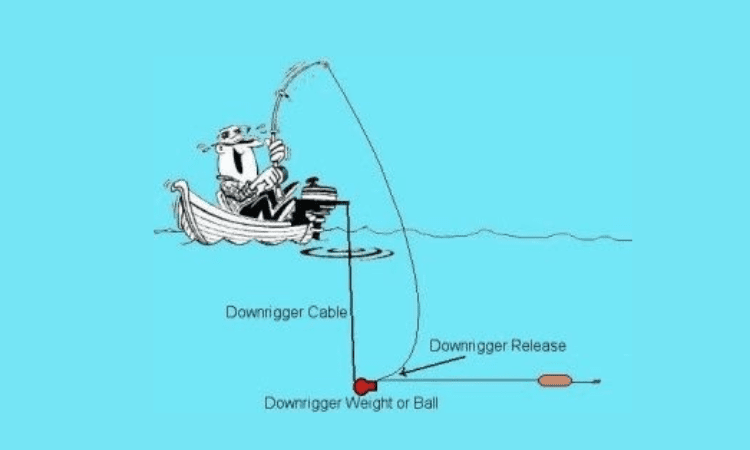Salmon fishing is more than just a hobby; it’s also a scientific pursuit, an artistic endeavor, and a thrilling experience. When it comes to fishing for salmon, downrigger trolling changes the game. In this comprehensive book, we’ll set sail and show you everything there is to know about downrigger salmon trolling. Everything from equipment and techniques to a grasp of this extraordinary fish’s behavior will be discussed. Let’s get started on learning the secrets of successfully landing a salmon.
How to Catch Salmon by Trolling:
Trolling is a common fishing method in which multiple baited lines are cast behind a moving boat. To take this technique to the next level while fishing for salmon, downriggers are an absolute necessity. Downriggers are high-tech tools that allow you to control the exact depth at which your bait or lures are presented to fish. This level of precision is essential while fishing for salmon, the depth of which varies depending on location and time of year.
Installing a Downrigger
To start trolling with downriggers for salmon, you’ll need the following equipment:
- The downriggers are the primary tool used in this procedure. A downrigger consists of a line spool with a weighted ball and a releasing mechanism. You may modify the depth of your lures and baits by installing these on your boat.
- Choose trolling equipment that can handle the weight and strength of a salmon, such as a rod and reel with a medium to strong drag. A line counter reel is incredibly helpful when you need to keep close tabs on the length of your line.
- Different-sized downrigger weights help you get to the water depth you want when trolling. Heavy weights are required for longer, deeper runs, whereas lighter weights are more suitable for shorter, shallower waters.
- Because of their picky tastes, salmon require a wide selection of lures and bait. Use flashers, dodgers, and hoochies of varying colors to lure salmon into your net.
Strategies for Trolling with Downriggers:
Here is a comprehensive guide on how to troll for salmon using downriggers:
- Determine Your Fishing Spot By looking into local reports, feeding habits, and salmon behavior. The depths and locations at which salmon are found change with the seasons.
- Establish Your Downriggers: After connecting the weights and lures to the downriggers, lower them to a suitable depth. Keep a close eye on your fishfinder to monitor the whereabouts of the salmon.
- Slowly and steadily move forward at a trolling speed of 1.5 to 2.5 miles per hour. This speed will keep your bait or lures at the ideal depth while mimicking the motion of prey.
- Use your fish finder to keep an eye out for strikes, and use it frequently. Keep an eye out for any unusual twitches at the rod tip, since salmon strikes can be quite subtle.
- At the first sign of a bite or strike on your line, you should quickly reel in the fish. Don’t let up on the pressure to keep the fish from getting away.
- Recognizing Salmon Behavior Knowing how these incredible fish behave is essential for successful trolling. Salmon are very migratory, and they tend to do so in schools. Their food habits change with the seasons and the geography. If you stay current on the salmon’s habits, you’ll have a better chance of catching one.

Strategy
- Using downriggers to fish for salmon is more than simply a technique; it’s an exciting adventure, especially when you catch one. Picture yourself on the open sea, in the midst of a breathtaking environment, angling for a prized salmon. The adrenaline rush of hooking a salmon and the elation of landing it are both incomparable.
- Depending on the conditions, salmon fishing can be done at any time of the year. To be successful when trolling for salmon, one must be familiar with the species’ seasonal habits and migration routes.
- Chinook and coho salmon, both of which spawn in the spring, are spring salmon. As the waters warm, certain salmon species become more receptive to being trolled. Spring salmon are highly sought after by anglers due to their size and strength.
- Pink and sockeye salmon are common throughout the summer, and they tend to stick close to the surface. Coho salmon persist at high numbers all summer long. Salmon derbies and tournaments are popular summertime events that bring people together to enjoy fishing for salmon as a community.
- The abundance of salmon in the fall is due to the return of several salmon species to their breeding sites. It is the peak fishing season for coho, chinook, and chum salmon. Schools of salmon return to freshwater rivers in fall, making it the perfect time to fish.
- Trolling for salmon in the winter is possible in some regions for the truly dedicated angler. The best months to pursue trophy-sized Chinook salmon are frequently during these dates.
- Fishing for salmon with a downrigger requires lots of planning and concentration. It’s about enjoying nature, watching the tides, and connecting with the ocean’s rhythm, not simply catching fish.
In conclusion:
Trolling for salmon with downriggers requires talent, gear, and understanding of these wonderful fish. That method guarantees adventure and a great catch for all skill levels. Learning downrigging can boost your confidence and help you catch legendary salmon. Unlock the secrets of successful salmon trolling with downriggers in our comprehensive guide.
From equipment and techniques to understanding salmon behavior, embark on an adventure that combines science, artistry, and thrilling experiences. Learn how to catch salmon like a pro and enjoy the excitement of landing a prized catch. You never know when you might get a lifetime catch, so get out there and start salmon trolling.

